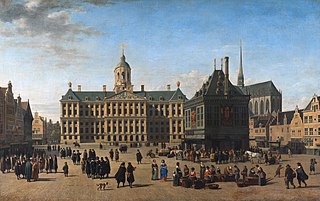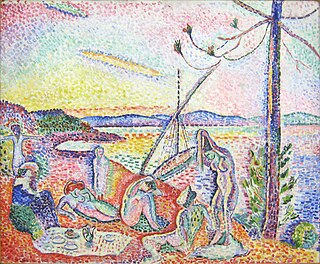
Pointillism is a technique of painting in which small, distinct dots of color are applied in patterns to form an image.

Paul Victor Jules Signac was a French Neo-Impressionist painter who, with Georges Seurat, helped develop the artistic technique Pointillism.

Giovanni Antonio Canal, commonly known as Canaletto, was an Italian painter from the Republic of Venice, considered an important member of the 18th-century Venetian school.

In the visual arts, a cityscape is an artistic representation, such as a painting, drawing, print or photograph, of the physical aspects of a city or urban area. It is the urban equivalent of a landscape. Townscape is roughly synonymous with cityscape, though it implies the same difference in urban size and density implicit in the difference between the words city and town. In urban design the terms refer to the configuration of built forms and interstitial space.

Francesco Lazzaro Guardi was an Italian painter, nobleman, and a member of the Venetian School. He is considered to be among the last practitioners, along with his brothers, of the classic Venetian school of painting.

Ca' Foscari, the palace of the Foscari family, is a Gothic building on the waterfront of the Grand Canal in the Dorsoduro sestiere of Venice, Italy.

Ca' Rezzonico is a palazzo and art museum on the Grand Canal in the Dorsoduro sestiere of Venice, Italy. It is a particularly notable example of the 18th century Venetian baroque and rococo architecture and interior decoration, and displays paintings by the leading Venetian painters of the period, including Francesco Guardi and Giambattista Tiepolo. It is a public museum dedicated to 18th-century Venice and one of the 11 venues managed by the Fondazione Musei Civici di Venezia.

Neo-Impressionism is a term coined by French art critic Félix Fénéon in 1886 to describe an art movement founded by Georges Seurat. Seurat's most renowned masterpiece, A Sunday Afternoon on the Island of La Grande Jatte, marked the beginning of this movement when it first made its appearance at an exhibition of the Société des Artistes Indépendants in Paris. Around this time, the peak of France's modern era emerged and many painters were in search of new methods. Followers of Neo-Impressionism, in particular, were drawn to modern urban scenes as well as landscapes and seashores. Science-based interpretation of lines and colors influenced Neo-Impressionists' characterization of their own contemporary art. The Pointillist and Divisionist techniques are often mentioned in this context, because they were the dominant techniques in the beginning of the Neo-Impressionist movement.

The Société des Artistes Indépendants or Salon des Indépendants was formed in Paris on 29 July 1884. The association began with the organization of massive exhibitions in Paris, choosing the slogan "sans jury ni récompense". Albert Dubois-Pillet, Odilon Redon, Georges Seurat and Paul Signac were among its founders. For the following three decades their annual exhibitions set the trends in art of the early 20th century, along with the Salon d'Automne. This is where artworks were often first displayed and widely discussed. World War I brought a closure to the salon, though the Artistes Indépendants remained active. Since 1920, the headquarters has been located in the vast basements of the Grand Palais.

The Arkansas Museum of Fine Arts (AMFA), formerly known as the Arkansas Arts Center, is an art museum located in MacArthur Park, Little Rock, Arkansas. The museum's most recent expansion and renovation was designed by architecture and urban design practice Studio Gang. During this time, it was closed to the public. It had its grand opening in April 2023.

Charles Angrand was a French artist who gained renown for his Neo-Impressionist paintings and drawings. He was an important member of the Parisian avant-garde art scene in the late 1880s and early 1890s.

The Toledo Museum of Art is an internationally known art museum located in the Old West End neighborhood of Toledo, Ohio. It houses a collection of more than 30,000 objects. With 45 galleries, it covers 280,000 square feet and is currently in the midst of a massive multiyear expansion plan to its 40-acre campus. The museum was founded by Toledo glassmaker Edward Drummond Libbey in 1901, and moved to its current location, a Greek revival building designed by Edward B. Green and Harry W. Wachter, in 1912. The main building was expanded twice, in the 1920s and 1930s. Other buildings were added in the 1990s and 2006. The museum's main building consists of 4 1/2 acres of floor space on two levels. Features include fifteen classroom studios, a 1,750-seat Peristyle concert hall, a 176-seat lecture hall, a café and gift shop. The museum averages some 380,000 visitors per year and, in 2010, was voted America's favorite museum by the readers of the visual arts website Modern Art Notes.

Palazzo Grassi is a building in the Venetian Classical style located on the Grand Canal of Venice (Italy), between the Palazzo Moro Lin and the campo San Samuele.

The Lagoon of Saint Mark, Venice is an oil on canvas painting by Paul Signac. This painting focuses on a seascape image which became a common theme late in Signac's life.

The Grand Canal in Venice from Palazzo Flangini to Campo San Marcuola is a painting by Canaletto in the J. Paul Getty Museum in Los Angeles, California. Painted around 1738, it may have been commissioned by the English merchant and art collector Joseph Smith (1682–1770).

Le Grand Canal is an oil on canvas painting by French Impressionist painter Claude Monet (1840–1926). It is one of six paintings looking down the Grand Canal towards the Salute church. This Grand Canal series is in turn part of a larger series of paintings of Venice which Monet undertook during 1908 on his only visit to the city. The artist is generally regarded by art historians as being at the peak of his powers at this period. The paintings were begun en plein air and completed in France.
Monet painted 37 works of Venice which he began during his stay in the city in 1908. These include a series of canvases of the Grand Canal. He had the habit of studying the same subject in a varying light, at different times of the day, which resulted during his career in many distinct series, like for example the Water Lilies series, Poplar series, Rouen Cathedral series, Haystacks series and Charing Cross Bridge series.

The Entrance to the Grand Canal, Venice, is a c. 1730 oil painting on canvas by the Venetian painter Canaletto. It is a Rococo landscape painting measuring 49.6 by 73.6 centimeters currently held as part of the Robert Lee Blaffer Memorial Collection in the Audrey Jones Beck Building at the Museum of Fine Arts, Houston, in Houston, Texas. It was a gift from Sarah Campbell Blaffer.
Entrance to the Grand Canal, Venice may refer to:

















